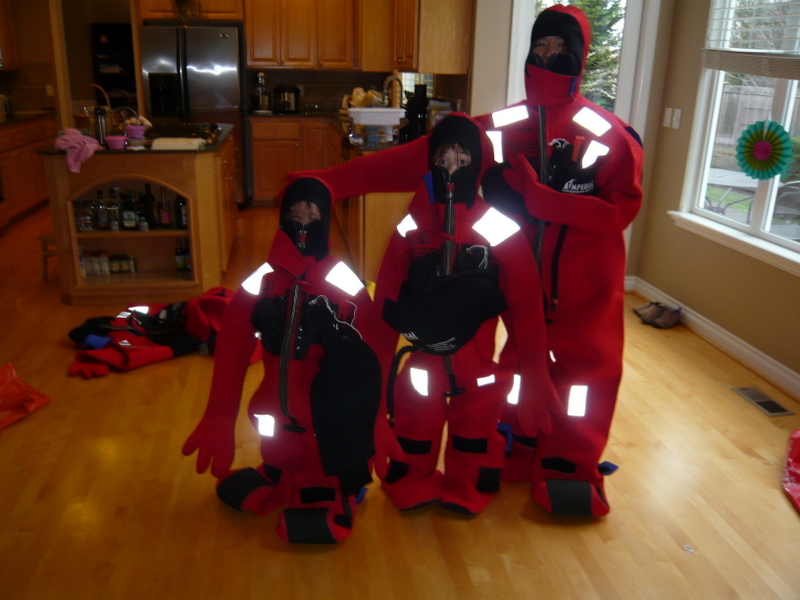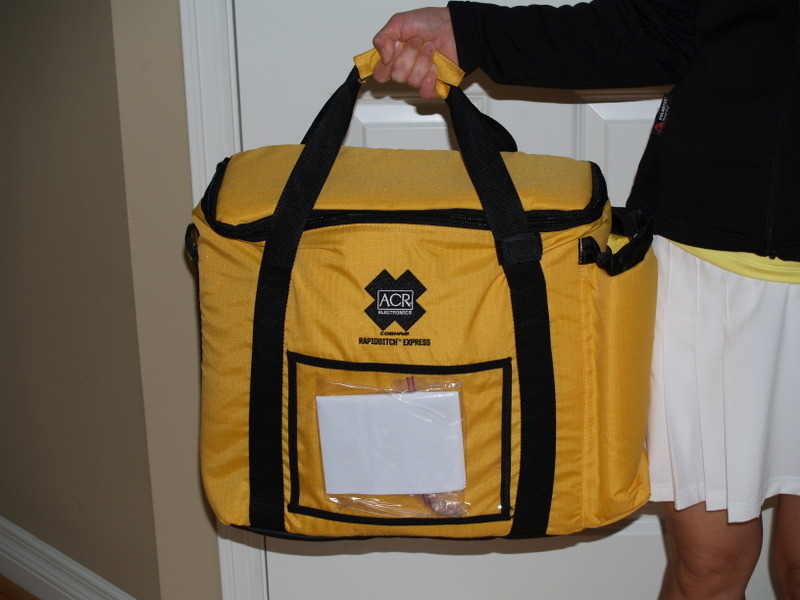- Boat
- Articles
- About
- Tehani-li Logs
- 2004
- Uligan Maldives
- Man, Oh Man, Oman
- Eritrea: The Nicest Place You’ve Never Heard Of
- Cruising Notes: Oman to Eritrea – From Pirates to Cappucinos
- Old Testament Sudan
- Egypt: Legend, Myth and Reality
- Thoughts on Cruising the Red Sea
- Greece: Civilization Again
- Montenegro
- Malta
- Sardinia, Italy
- Barcelona, Spain
- 2003
- 2002
- 2001
- 2004
- Contact
Our Abandon Ship Bag

Every boat heading offshore needs one and an abandon ship bag, or “ditch bag” is just like life insurance. The contents may save your life but putting one together and thinking through the implications, calculations and complications is much like applying for life insurance: unpleasant but probably a damned good idea.
Like most cruising boats, we have a life raft on deck ready to go if needed. The only situation I can foresee that being necessary is if we meet with a fire on board or a collision at sea which causes the mother ship to sink. Bad weather I don’t believe will figure into it as if it is bad enough out there to sink the big ship, God forbid you test it out in a dinky little rubber raft. The only time we would launch the life raft is basically when we try everything else first and then finally have to step UP into it.
We decided on a Revere Offshore Elite 6 person life raft in a cradle. According to the brochure, it offers “a spacious 4 square feet per person.” What a joke. What is spacious about 4 square feet? You don’t want the raft too big, however, as stability becomes an issue. We are four souls on board so I went with the six man job.
The life raft itself comes with its own emergency kit which contains some flares, a signal mirror, a fishing kit, seasick tablets, drinking water, flashlight, first aid kit and a whistle. The quality of which is at best undetermined and it may not even be there at all if the raft was thrown together on a Friday afternoon and somebody “forgot.”
Don’t be an ass
Going on the old rule, “When you ‘assume’ you make an ‘ass’ out of ‘u’ and ‘me,’” I felt compiling our own ditch bag was a sensible idea. I looked at different bags to start. I wanted something with positive buoyancy that was also highly visible. I thought about Pelican cases but swinging something rock hard around in an emergency could easily knock someone out. I looked at kayaker’s wet bags but organizing the contents inside and holding on to it proved problematic. In the end I decided on the bright yellow “RapidDitch Express” by ACR (the same people who make EPIRBs), which cost $55.

The bag floats, or so I’m told, but at least I can see it has foam padding stitched inside the walls which will help. It also has a pocket for your EPIRB that cinches up at the top, a nice feature in a full blown panic.
Abandoning ship
It is essential to make sure you set off that EPIRB first before abandoning ship – and bring the damn thing with you into the life raft. We keep ours mounted to the wall right next to the companionway in a place I can reach from the cockpit but which is protected from the weather. We also have two smaller EPIRB-like PLBs that Ariel and I wear on night watches. They are the “Fast Find GPS Personal Locator Beacons,” manufactured by McMurdo and which work using the same 406 MHz COSPAS-SARSAT system the big EPIRB uses. We would try to bring those into the raft as well but who knows. All I know is in a catastrophe our system would (try and) work like this:
1) Set off ship’s EPIRB
2) Everyone into their survival suits: children first, me last
3) Deploy life raft and get family inside
4) Grab EPIRB and ditch bag and jump (up) into raft
5) Cut painter that holds raft to now rapidly sinking ship
As we sail in colder waters now we have invested in “Immersion Suits,” otherwise known as survival suits. All commercial craft, such as fishing boats, are required to carry one per crew up here (Seattle). Ours are made by Imperial and they make you float and keep you alive for 12 or more hours in the cold waters of Alaska and the Pacific Northwest. Without one, bobbing about in the water you might last 30 – 60 minutes. For that protection, expect to pay around $265 for each. Not expensive when you think about it. They come in several sizes, including for children.
A firm “No” to SSB or Ham radio
I would not waste any time at all on the radio, especially SSB or Ham. We sail in places that are usually far from civilization (that’s the point of having an ocean-crossing vessel) which rules out good old channel 16 on the VHF. SSB, or Ham, is fine for hobbyists with plenty of time on their warm, dry hands. We have had one (Icom M710) for years and to be honest it is mainly a waste of time. You have to find the proper frequency at the proper time, make sure propagation is right – wait, it isn’t? Try again in six hours, buddy. Any doubts I had after using the radio for a long time were reinforced into firm belief when Ariel and I were being chased by ne’-er-do-wells (pirates?) in the Indian Ocean for 12 hours. We tried every damn frequency on the SSB/Ham rig, including the so-called “Distress frequency” 2182 kHz and were met with the predictable wall of silence. If the ship is really sinking you won’t have time to play the hobbyist: take control, grab the EPIRB and get everyone into the raft.
I should also note we now have an Iridium phone on board but I have yet to use it. I can’t say from experience if this would be another viable method of contacting somebody in an emergency if we had the luxury of time. Maybe.
So what are we putting into the ditch bag? Here is what I have:
EPIRB
Icom Handheld VHF
Handheld GPS
SeaPack Crew Emergency Desalination Pouch – This is such a neat idea, so let me digress a bit. On my first boat, Galileo, a Cape Dory 33, I singlehanded and carried a PUR handheld RO water maker. It was ludicrously expensive and ludicrously difficult to use. There is no way you could use that to make water if you were injured or in a weakened state. SeaPack makes a “passive filter” that over an 8-hour time period turns seawater into drinking water. Each pouch makes half a quart (17 oz) and the bag comes with three for $35.
Thermal blankets for all
Laser signal (Greatland Laser)
Cutting board (for fish)
Sealed batteries
Tupperware – for bailing, storage and fecal/urine disposal. Just won’t use if for salads afterward.
Copies of passports
Small first aid kit
Small fishing kit
Folding knife – I will probably file the point off the blade tip
Emergency drinking water packets
Sunscreen
Hats for all
Sunglasses
Signal mirror – I will use an old CD
Whistle
Waterproof LED flashlight
Compass
“Rescue” kite – I have a foldup kite that fits in the bag. It will make the raft more visible and attract attention. It might also give us something to do.
Toilet paper (might not be practical I admit, but makes the wife happy)
Nylon cord
Sponges
Emergency Food Rations (Mainstay 3600)
Lots of Cliff Bars
Ibuprofen
Vaseline
Book – for reading aloud. Need to get something other than Dr. Seuss.
Hair gel
I am in the process of packing it in the bag and it may not all fit. The hair gel may have to go.
1 Trackback
- What’s In Your...Ditch Bag? - The Seamless Sailor | The Seamless Sailor
December 16, 2014 6:59 PM


January 4, 2014
2:30 am #comment-1
Great list, and outfits! I have book marked this when I get our DB ready this spring.
January 5, 2014
2:19 pm #comment-2
Thanks! Good luck and may you never need it.
Derek
March 12, 2016
10:50 am #comment-3
I am in process of putting together our ditchbag, as we prep for our offshore sailing and eventual circumnavigation. Your list for the bag was almost identical to the one I created. As I considered water options, I came across the Seapack Desalination bags. Could you please tell me the approximate weight and size of each pack of three pouches? I would think that they would be lightweight and small, but I can not find the details on any website. Thank you so much for your assistance. (just started working on the webpage – lots more to do)
Fair Winds,
Marcia
March 15, 2016
8:34 pm #comment-4
Marcia,
I am not on the boat right now so I can’t give you exact details but we were able to fit one in the ditch bag easily. They are about the size of a freeze-dried backpacking meal, maybe a little thicker.
Hopefully your ditch bag will never see the light of day and good luck.
Derek